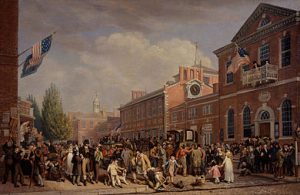Bastille Day Jams: Music to Lose your Head over
Alternate title: GuilloTUNEs
France’s Fourth of July takes place on the fourteenth of July – Bastille Day (or, as the French prefer to call it, the much nicer-sounding La Fête Nationale), the beginning of the French Revolution. Now technically, the real beheading party didn’t begin until a few years later, Still, the guillotine has become the iconic icon of French liberty and justice.
Which is why I bring you this – iconic French composer Hector Berlioz‘s “March to the Scaffold”, the fourth movement of his Symphonie Fanstastique. Written in 1830, after two generations of political turmoil, it is a testament to the hardiness of humanity and our need for beauty in an ugly world. This Symphony is historically important because it fueled the romantic obsession of programmatic music; it also introduced an idea Berlioz called the idée fixe – a musical motif or melody which is attached to a specific thought, person, or idea. Out of the context of the whole symphony, the idée fixe won’t have much meaning when you listen to this single movement. However, that doesn’t mean you won’t enjoy it.
Programmatic music is the idea that music can convey a non-musical story or idea. Sometimes programmatic music composers can be cryptic; other times they are very specific. Berlioz is the latter! He provided this awesome, drug-inspired summary of this head-rolling movement:
Convinced that his love is unrequited, the protagonist poisons himself with opium. The dose of narcotic, while too weak to cause his death, plunges him into a heavy sleep accompanied by the strangest of visions. He dreams that he has killed his beloved, that he is condemned, led to the scaffold and is witnessing his own execution. The procession advances to the sound of a march that is sometimes somber and wild, and sometimes brilliant and solemn, in which a dull sound of heavy footsteps follows without transition the loudest outbursts. At the end of the march, the first four bars of the idée fixe reappear like a final thought of love interrupted by the fatal blow.


Recent Comments